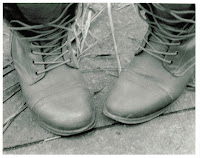“Photography can never grow up if it imitates some other medium, it has to walk alone, it has to be itself.” - Berenice Abbott lived her life around this quote.
Berenice Abbott was born in Springford, Ohio on July 17th 1898. She lived a very normal childhood. Her artistic lifestyle began when studied at Ohio State University. After studying at Ohio State she moved to New York City to study journalism. Very quickly she found that this was not the career for her, so she decided to try sculpting and painting. She discovered this was a much better career path.
She moved to Paris, France, in 1921 where she worked as a mentor with sculptor Emile Bourdelle. After working with Bourdelle, Abbott was introduced to surrealist photographer Man Ray. Ray was very influential in the development of her art career, sparking lots of interest in the photography world.
After working with Man Ray for a while, she decided to open her own studio in Paris. Shortly after, she hosted her first solo exhibition in 1926 at Au Sacre Du Printemps Gallery.
After her first exhibition she decided to pack up and move back to New York City where she had a big influence on the Depression Era. Abbott is most commonly known for her photographs of the neighbourhoods, street life and architecture during the depression in New York.
These photographs are featured in a book entitled ‘Changing New York’ published in 1939, which outlined the struggles of the depression.
Berenice continued with photography into her later years of life until her death on December 9th 1991, in Monson, Maine.
----------
Berenice Abbott’s photographs provide us with a strong visual representation of the diversity during the Depression Era. She chose to photograph New York City. This was not her initial intention but during her three-week trip to New York City she loved it so much she decided to stay. She was intrigued by the contrast between the wealthy and the utterly poor and decided it needed to be captured. She also believed that the only medium that qualified for this undertaking would be twentieth century cameras.
 |
| Tri Boro Barber School, 1935 |
“Tri Boro Barber School” is one of Berenice’s most well known pieces. This image, captured in 1935 on 264 Bowery St, Manhattan, really represents her style. She photographed hundreds of storefronts, as a way of showing people the past, capturing the differences between today and yesterday. It shows in the picture that times have truly changed. A hair cut in 1935 cost 10 cents where as today it costs about 300 times that. What is truly incredible about this picture is her way of capturing such strong contrast in the picture, including the painting on the building to the items reflected in the storefront.
 |
| 1929 |
Another popular piece of Abbott’s is a picture taken on West Street, in Manhattan. This was taken in 1929 after she arrived in New York. This photograph has both beautiful contrast and composition. I love the angle that this image was taken on as it really shows the depth of the city. The horse drawn vehicles and open back delivery trucks demonstrate what life was like in the 1920’s and 1930s.
 |
| House Number 8, 1936 |
Finally, one of her other popular pieces is of House Number 8 on Fifth Avenue, 1936. This picture highlights the disparity between the rich and the regular class people. A rich family owns the right side of the house as is clearly defined by the clad marble on the exterior. The middle class family’s whose home is clad with red bricks. I also love the perspective of this photograph showing the full exterior of the homes. Overall, I love the contrast between the two and think that this nicely demonstrates the different classes of wealth at the time.
After completing some research on how she composed her images and reviewing some of her beautiful collections of work I was really hooked on her photography. Her pieces are absolutely beautiful. Once I had decided on having Berenice Abbott as my mentor assignment, I had the difficult task of mimicking her style.
----------
To begin the assignment I went for multiple walks with my camera. I wandered through quieter and busier areas of downtown Oakville. I was in search of beautiful buildings, as we are no longer living in the depression so shooting architecture was my only option.
I took many pictures of buildings I thought were stunning until I came across the one I knew was going to be my project. I ended up finding this subject at the corner of Trafalgar and Dunn. This residential property has a more traditional style architecture, which looked beautiful in the setting sun.
I set my camera at a f16 with a shutter speed of 1/60th to take this photograph. Once I had my negative I chose to overdevelop the film to make the photograph have even more contrast. This worked out great mimicking the style of Abbott. Next I developed the negative into a positive print and I was amazed at the detail in the picture! Here is my final result:
 |
| Canon 35mm, f16, 1/60th |
Bibliography:

















